 Abraham Lincoln
If given the truth, the people can be depended upon to meet any national crisis...
Abraham Lincoln
If given the truth, the people can be depended upon to meet any national crisis...
 Guildford news...
for Guildford people, brought to you by Guildford reporters - Guildford's own news service
Guildford news...
for Guildford people, brought to you by Guildford reporters - Guildford's own news service
Floods of 1900 When the Town Bridge Was Swept Away
Published on: 28 Dec, 2023
Updated on: 28 Dec, 2023
By David Rose
Widespread flooding occurred in the Guildford area in February 1900, which saw much of the Town Bridge was swept away.

The remains of Guildford’s Town Bridge after the February 1900 floods. Picture: David Rose collection.
The damage and havoc that was wreaked was reported in minute detail in the Surrey Times in its editions of February 17 and 24.
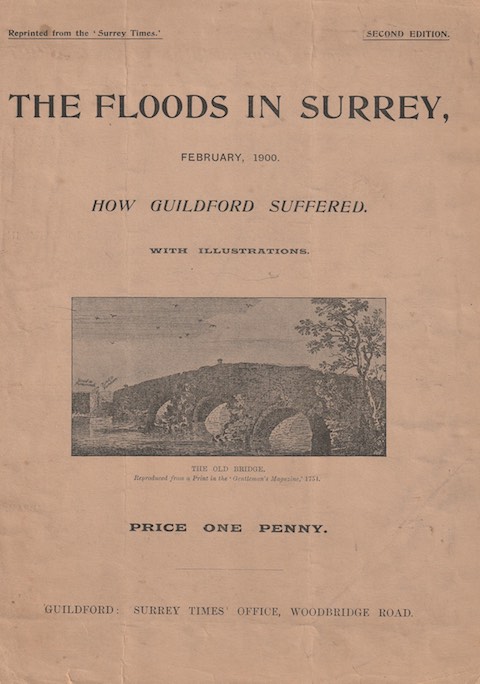
Cover of the Surrey Times’s souvenir (second) edition of the February 1900 floods. Picture: David Rose collection.
Copies sold out rapidly and later the newspaper published a 12-page souvenir edition, copies of which were kept by people for many years, even to this day!
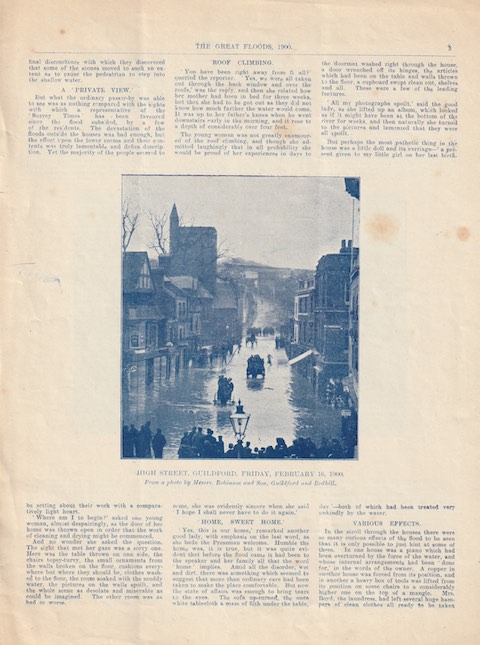
Page 3 of the Surrey Times’s souvenir supplement of the February 1900 floods. Note it is a slightly different photo to the one seen below. Picture: David Rose collection.
The Saturday, February 17 edition reported:
“This morning the chief object of interest was undoubtably the collapsed bridge. The worst fears which were entertained when last evening a portion of it gave way were unfortunately realised, and the main structure is now a complete wreck. The tremendous strain of the water, increased enormously by the tons of timber driven against it, was more than the bridge could have withstood even if the crown had not been forced up, as it was on Friday. Indeed, the marvel is that under the circumstances it could have lasted so long. Efforts to relieve the strain by the removal of the timber nobly undertaken by men under the direction of the surveyor, had to be abandoned, because the huge balks and planks came down much faster then they could be extricated, and, moreover, the men were working at considerable peril to themselves.”
The timber had been washed away from Moon’s timber yard that was next to the bridge (where the empty Debenhams store is today).
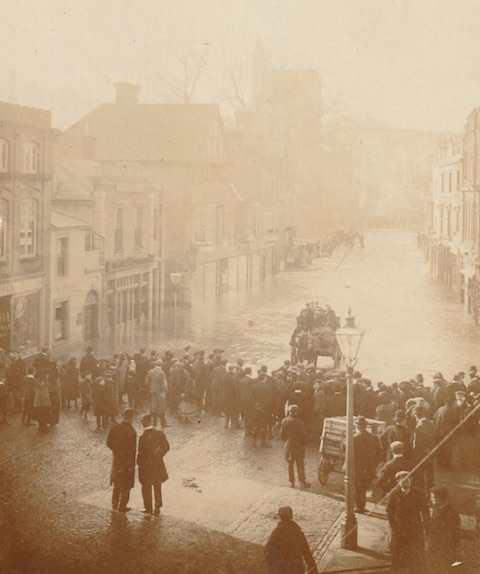
People watch as horse-drawn vehicles cross the Town Bridge. Picture: David Rose collection.
However, as photos from the 1900 floods show, horse-drawn vehicles were being driven over the bridge while the floodwaters were all around and before the bridge was swept away. And scores of people stood at the foot of the High Street to view the floods.

Photo taken from the bridge looking up the High Street. Picture: Guildford Institute collection.
The damage was not only confined to the bridge as the report continued:
“One of the most serious consequences of the breaking up of the bridge was the fracture of both water and gas mains, which mean that the whole of the town on the Portsmouth Road side and the Guildown estate was last night plunged into darkness and deprived of water supply. The noise of the bursting of the mains was heard at a considerable distance. To prevent the waste of water from the mains, prompt measures were taken to turn off the supplies. This was the more essential on account of the state of the water works and the necessity of husbanding the store of water in the reserves.”
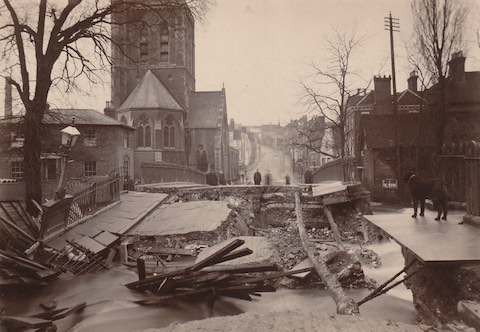
This photo shows the damaged bridge and the gas and water mains. Note the dog on the right taking a look! Picture: David Rose collection.
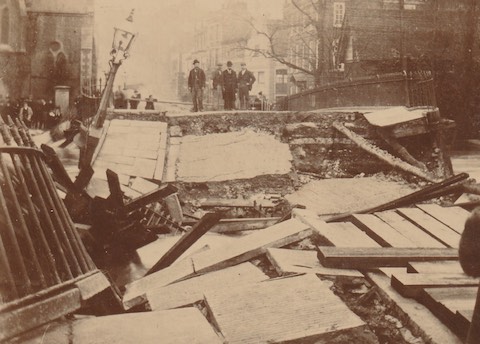
Photo from the same direction. Note the people standing on the part of the bridge that remained. David Rose collection.
Photo taken from the opposite direction. Picture: David Rose collection.
The report continued:
“Early in the morning men were at work in Bridge Street making the necessary trench to lay in the connecting pipe between the dead end of the main near Mr How’s and the Farnham Road main at the Railway Hotel. This will enable the district to receive a regular supply of water.”
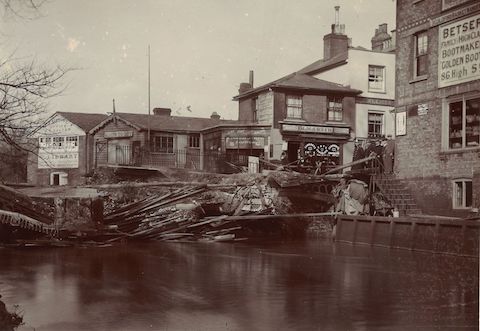
The damaged Town Bridge with Henry Martin’s premises next to it on the north side. Picture; Guildford Institute collection.
The Mr How mentioned may been Harry How. He had a bakers and confectionary shop adjacent to the town bridge (down stream) and sold his home-made ginger beer as well as hiring out rowing boats. It appears he took over from Henry Martin whose premises can be seen in some of the 1900 flood photos.
As to the cause of the floods, the Surrey Times noted:
“The rainfall on Thursday, according to Mr Powell’s rain gauge at Piccards Rough, was 1.3 inches. Great as this is it would not have accounted for the tremendous flood had it not been for the depth of snow lying on the land and hills. The three recent falls of snow had caused an accumulation in places 12 inches in thickness, and the frozen state of the snow prevented the rain soaking at all into the ground. Hence it found its way without loss in bulk – rather with increased volume – into the water courses.”
Herbert Powell and his wife Beatrice lived at Piccards Rough in St Catherine’s Village. During the First World War he was made a temporary lieutenant colonel in the Royal Army Medical Corps and administered the military war hospital that occupied the Guildford Union Workhouse in Warren Road. At the start of the war Beatrice was appointed commandant of the Voluntary Aid Division of the Guildford District of the Red Cross. The Powells also gave Piccards Rough as a wartime convalescent home for military personnel.
Back to the floods and there was “excitement” at the “difficult” rescue of inhabitants of cottages in Millmead. The Surrey Times reported:
“It was impossible to reach them even by boat from the front of their houses, and water of considerable depth also cut off their retreat into Bury Fields. A boat was obtained and launched in the passage at Millmead. The occupants of small cottages were helped through the narrow casements from the upper rooms into the boat and thence dispatched to St Nicolas’ Hall. Three or four cottages in a row were emptied and, none too soon, for the water was within three inches of the kitchen ceilings. It was impossible to reach the occupants of the end cottage – Mrs Notridge and her son, , who were imprisoned in the upstairs rooms. The back windows were so small that it was impossible for them to squeeze through.”
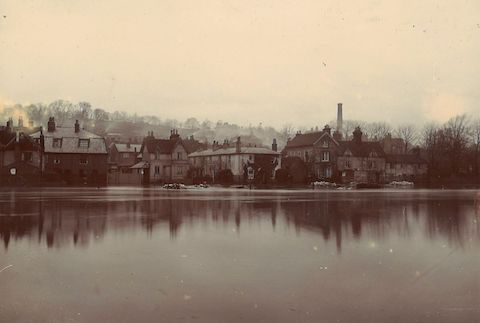
Millmead during the February 1900 floods. Picture: Guildford Institute collection.
And….:
“Some portly dames, who were among the rescued, seemed to regard their rescue as a joke. ‘How I ever got through that window I can’t think,’ declared one, and our representative, glancing at the tiny casement and the ample proportions of the speaker, had to agree that it was marvellous.”
There had been plenty of people in town watching the floodwaters as they rose, even before the Town Bridge collapsed. These floods appear to be the first disaster of its kind in Guildford to be photographed in so much detail.
Although images had been allowed to be published on postcards since 1894, the boom in picture postcards and especially those with topographical views had not yet begun in 1900. It would seem the first postcards with views of Guildford were not published until 1901. Of course, the floods resulting from Guildford’s great storm on August 2, 1906, was liberally photographed and issued on picture postcards.

Taken from almost underneath the Town Bridge, this shows the damaged part. Picture: Guildford Institute collection.
It seems the majority of the 1900 floods photos were taken by local photographer such as E. W. Bradden and Robinson & Son. Prints were made, mounted on card, and sold locally and people kept them as souvenirs.
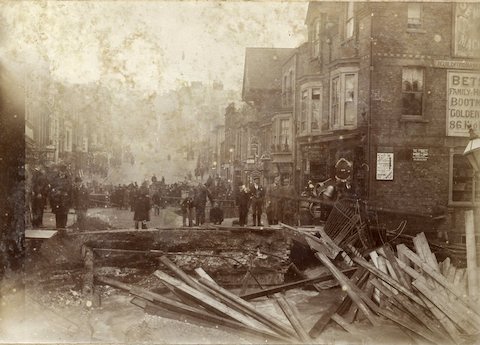
People taking a look at the damaged Town Bridge. Picture: Guildford Institute collection.
The Guildford Institute has a good collection of the February 1900 floods.
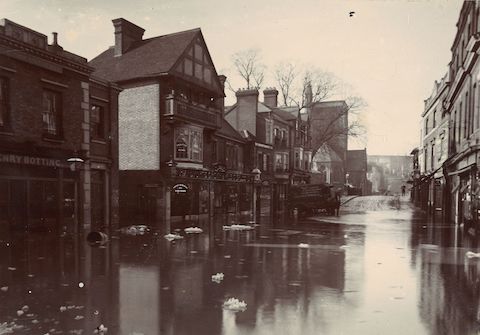
This view of the floods was taken when many people stood to watch the spectacle. Note: in this view the bridge has yet to collapse. Picture: Guildford Institute collection.
The Millmead area certainly contained slum housing at the time. The Surrey Times’ flood reports gives a vivid images of what it was like back then.
“In a few cases it was impossible to repress the feeling that apart from the flooding there was a good deal that was undesirable in the character of the old-fashioned buildings. Dark, low and ill-ventilated some of them are, and it is a question how far it is desirable that they should ever again be ‘got straight’.”
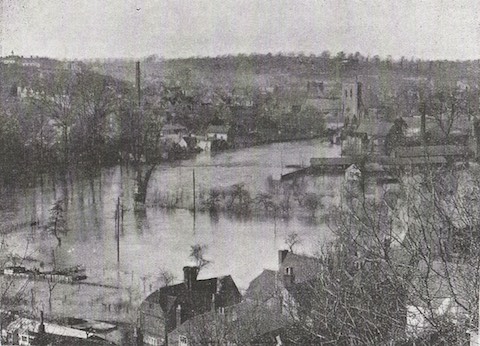
A view looking over the flooded Millmead area. Picture from the Surrey Times’s souvenir supplement. David Rose collection.
Houses on the opposite of the river at the foot of Quarry Street were also flooded. At one of them the owner brought his pigs up from a sty at the bottom of his garden by the river and:
“Gave them temporary shelter in the passage of the house.”
The reporting also included those of traders in the town, including the fledging vehicle makers Dennis Bros, who at the time had premises in the High Street just up from the Town Bridge. The following year brothers John and Raymond Dennis would occupy new premises in Bridge Street (that had been speculatively built as a commercial building) where they would soon expand their motor vehicle building empire:
“Messers. Dennis Bros, cycle manufacturers, did not become aware of the floods until arriving at their premises about nine o’clock on Friday morning, when they found the shop was covered in water to the depth of about a foot. They waded through the stream to the door and effected an entrance. Luckily they found that owing to a number of bicycles hung on stands the water had not reached them. Setting to work with a will some 70 machines were removed in quick time to their factory.”
At the time of the floods, John and Raymond Dennis also occupied premises (their “factory”) in the former militia barracks off Friary Street, and it seems that was not affected by the floods. However, the report also notes that in their shop 200 saddles were damaged by the flood waters along with a large number of accessories, and the brothers complained that they should have been informed by the authorities the flood water was rising!
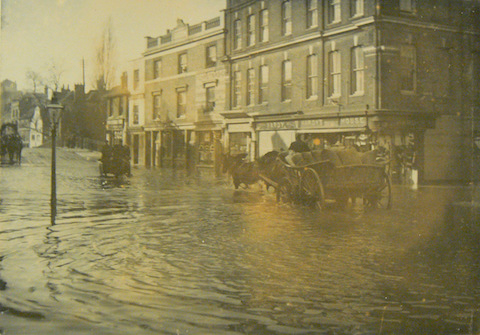
Horse-drawn vehicles make their way through the flood water. Mr Hardy’s shop can be seen on the right. Guildford Institute collection.
Mr Hardy’s drapery and clothes shop on the corner of High Street and Friary Street stood the full force of the flood waters as they rushed in from the river. The report continued:
“Mr Hardy, his son and three assistants spent about four hours in the water removing as many of the goods as possible to the upper stories of the building. But the race was too fast and the waters won in the end. The clothing department suffered most of all, a large number of men’s ties, clothing, boots, shirts and collars being badly treated by the water.”
The family firm was still in business in 1968 and suffered badly once more during the infamous floods of mid-September that year.
Another once long-standing local trader was Colebrook the butchers. Along with its shop further up the High Street (where a part of House of Fraser had been in more recent years) Colebrook’s also kept animals in a yard off Friary Street:
“The way in which the water dashed through the premises of Messers Colebrook, in Friary Street, rendered the task of rescuing the cattle and sheep in the yards one of great difficulty. Mr B. Colebrook and some of the employees were busy for some hours getting the shivering animals out of the water. There were nearly a dozen horses and a considerable number of beasts and sheep. The sheep had to be carried through the flood by men wading in water up to their waists.”
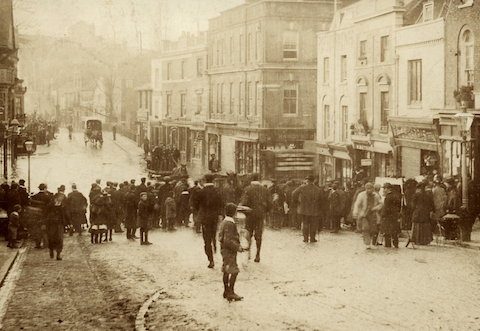
People kept on coming to see what the floods were doing to the bottom of the town – before the bridge collapsed! Picture: Guildford Institute collection.
Crooke & Co’s brewery was on the west bank of the River Wey, where the car park by the George Abbot pub is today. The Crooke family lived in a house next to the brewery. The report noted:
“At Messers Crooke’s brewery great damage has been done, in fact, even at a late hour on Saturday morning the extent of the loss could not be realised. Every part of the brewery and the residence has been affected and in some places the water has reached a depth of nearly six feet. In the private residence of Mr Crooke every room on the basement was affected: in the dining-room the tables and chairs floated about and in the library many books were completely spoiled.”
The Surrey Times conducted an interview with William Stevens, who it noted at the time managed the River Wey navigation:
“A representative of the Surrey Times, who called on Mr Stevens, elicited from him the fact that he had never seen the river so high as it was on Friday, and from what his father had told him there had not been such a flood since 1824. In that year it was a May flood, following upon 72 hours’ rain. If anything, Mr Stevens believed the water was then higher than it was on this occasion. One of the most remarkable features of the flood, according to Mr Stevens, was the rapidity of which the waters rose. Floods in the Wey valley frequently rise very quickly, but not to the same extent as the present one.”
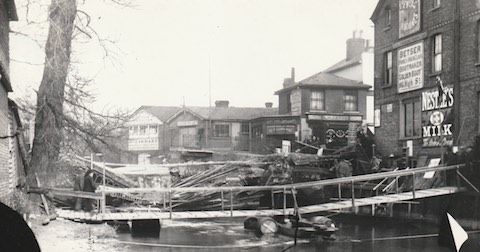
The temporary footbridge next to the Town Bridge that, itself, was beyond repair. The footbridge doesn’t look very safe either! Picture: David Rose collection.
A temporary footbridge was put in place a few feet upstream of the wrecked Town Bridge.
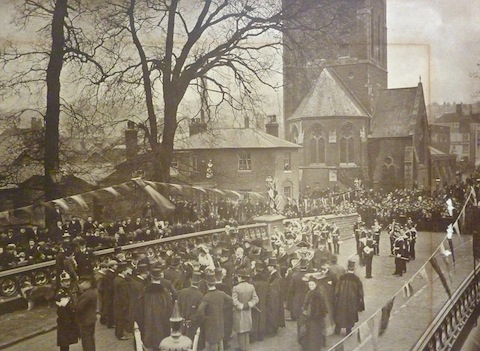
The grand opening of the new Town Bridge in February 1902. Picture: Guildford Institute collection.
Parts of the old bridge dated back to medieval times and it was of course beyond repair. A new bridge was built that opened with a grand celebration in February 1902.
Responses to Floods of 1900 When the Town Bridge Was Swept Away
Leave a Comment Cancel reply
Please see our comments policy. All comments are moderated and may take time to appear. Full names, or at least initial and surname, must be given.Recent Articles
- Is GBC Britain’s Most Wasteful Council? Asks National Paper
- Letter: Police Performance Issues I Encountered Were Administrative, Not Operational
- Loseley House Closed for ‘Gentlemanly’ Filming
- Opening 3-0 Loss for City But Scoreline Does Not Tell the Whole Story
- Letter: Worplesdon Parish Council – Only Guilty of Being Good
- ‘Emergency’ Roadworks Commence Without Warning, Closing Portsmouth Road
- Police Investigate Public Order Offence in Walnut Tree Close
- Woman Arrested After Guildford Town Centre Assault – Witnesses Sought
- Guildford Among Top Quarter for Recycling Rejection Rates in the South East, New Data Reveals
- Highways Bulletin: Roadside Rangers Making a Visible Difference Across Surrey



Recent Comments
- Stephen Spark on Letter: Campaign to Gauge Opinion on Restoring the Railway Line to Cranleigh
- Ian Macpherson on ‘Emergency’ Roadworks Commence Without Warning, Closing Portsmouth Road
- Jeremy Holt on Police Investigate Public Order Offence in Walnut Tree Close
- Gavin Morgan on Letter: The Enduring Role of Parish and Town Councils
- Tanya Scrivener on Letter: The Enduring Role of Parish and Town Councils
- Jim Allen on Letter: The Enduring Role of Parish and Town Councils
Search in Site
Media Gallery
Dragon Interview: Local Artist Leaves Her Mark At One of England’s Most Historic Buildings
January 21, 2023 / No Comment / Read MoreDragon Interview: Lib Dem Planning Chair: ‘Current Policy Doesn’t Work for Local People’
January 19, 2023 / No Comment / Read MoreA3 Tunnel in Guildford ‘Necessary’ for New Homes, Says Guildford’s MP
January 10, 2023 / No Comment / Read More‘Madness’ for London Road Scheme to Go Ahead Against ‘Huge Opposition’, Says SCC Leader
January 6, 2023 / No Comment / Read MoreCouncillor’s Son Starts Campaign for More Consultation on North Street Plan
December 30, 2022 / No Comment / Read MoreCounty Council Climbs Down Over London Road Works – Further ‘Engagement’ Period Announced
December 14, 2022 / No Comment / Read MoreDragon Interview: GBC Reaction to the Government’s Expected Decision to Relax Housing Targets
December 7, 2022 / No Comment / Read MoreHow Can Our Town Centre Businesses Recover? Watch the Shop Front Debate
May 18, 2020 / No Comment / Read More








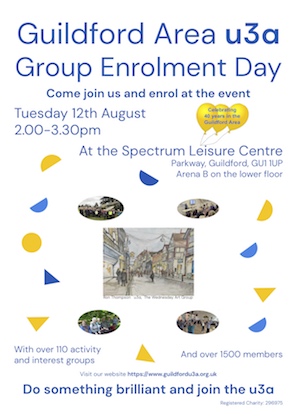


Kevin Murphy
December 28, 2023 at 7:51 am
Wow, I didn’t know about the major flood and the damage it did to the bridge in Guildford nearly 124 years ago.
Looking at the pictures I felt sorry for the business affected then.
I was born in North Holmwood near Dorking in 1962. I went to school in Merrow, Guildford.
My late [relative?] travelled to Guildford to work when I was six-years-old until I was 15. I did hear about the 1968 floods from my mum and dad.
Thank you for your information and pictures of the the major flood in February 1900.
Jim Allen
December 30, 2023 at 10:14 pm
The ’68 floods were another story! Between Ash and Reading there was only one bridge passable on the River Blackwater at Blackwater railway station on the A30. Impassable anywhere else for multiple days!
The flood plains were Flooded! The full length it wus the Acid rain which caused it! then not Climate change!
Harold Campbell
December 29, 2023 at 7:44 pm
Many thanks for a great article.